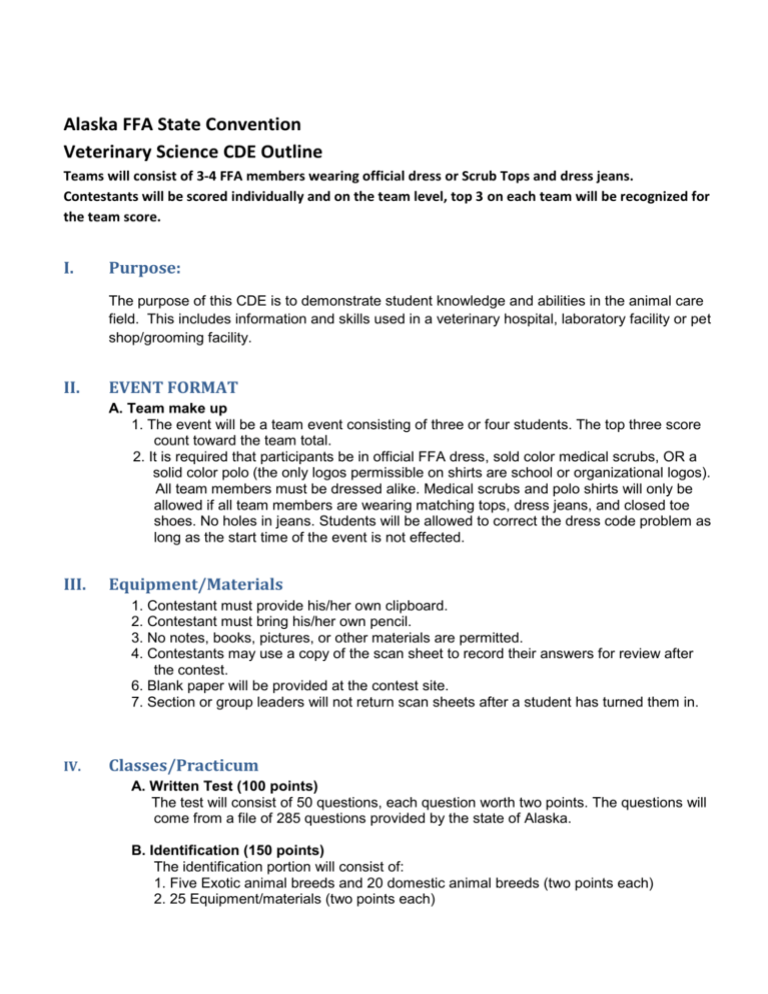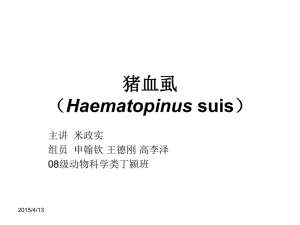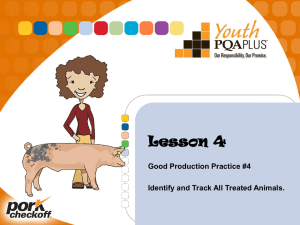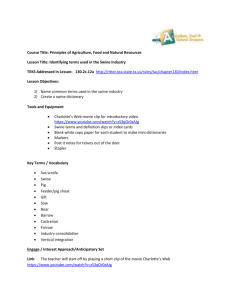Vet Science - WordPress.com
advertisement

Alaska FFA State Convention Veterinary Science CDE Outline Teams will consist of 3-4 FFA members wearing official dress or Scrub Tops and dress jeans. Contestants will be scored individually and on the team level, top 3 on each team will be recognized for the team score. I. Purpose: The purpose of this CDE is to demonstrate student knowledge and abilities in the animal care field. This includes information and skills used in a veterinary hospital, laboratory facility or pet shop/grooming facility. II. EVENT FORMAT A. Team make up 1. The event will be a team event consisting of three or four students. The top three score count toward the team total. 2. It is required that participants be in official FFA dress, sold color medical scrubs, OR a solid color polo (the only logos permissible on shirts are school or organizational logos). All team members must be dressed alike. Medical scrubs and polo shirts will only be allowed if all team members are wearing matching tops, dress jeans, and closed toe shoes. No holes in jeans. Students will be allowed to correct the dress code problem as long as the start time of the event is not effected. III. Equipment/Materials 1. Contestant must provide his/her own clipboard. 2. Contestant must bring his/her own pencil. 3. No notes, books, pictures, or other materials are permitted. 4. Contestants may use a copy of the scan sheet to record their answers for review after the contest. 6. Blank paper will be provided at the contest site. 7. Section or group leaders will not return scan sheets after a student has turned them in. IV. Classes/Practicum A. Written Test (100 points) The test will consist of 50 questions, each question worth two points. The questions will come from a file of 285 questions provided by the state of Alaska. B. Identification (150 points) The identification portion will consist of: 1. Five Exotic animal breeds and 20 domestic animal breeds (two points each) 2. 25 Equipment/materials (two points each) 3. 25 Parasites and animal body parts (two points each) a. The student will look at magnified pictures and correctly identify internal and external parasites. The student will also correctly identify internal organs from cats, dogs, swine, cattle, sheep, goats, or horses. Eternal Anatomy will also be tested on dogs, cats, and rabbits. Each identification will be worth two points. These will come from the list provided by the Alaska FFA. Animal body part may be a picture or real body part. V. Veterinary Science Skills Individual Practicum Rotation (100 points) 1. Possible Practicum a. Equipment and tool identification (list of possible provided) b. Anatomy/ Parts Identification (list of possible provided) c. Math Problems, dosage calculations, feed calculations d. Sexing animals e. Filling out medical records chart f. Reading an animal drug label g. Scheduling appointment and collecting necessary patient information h. Customer service, verbal or written i. Properly fill a syringe and administer medication (score sheet provided) j. Carrying a Cat k. Removing a dog from cage or kennel l. Administering Aural Medication m. Restraint of a Rabbit VI. TOTAL TEAM SCORE Written Exam…………….….100 points Identification……………...…150 points Skills practicum……...….......100 points TOTAL POINTS INDIVIDUAL …….….….350 points TEAM…………………..1050 points VII. TIEBREAKER Team and Individual tiebreakers will be settled in the following order: 1. Team with the higher score in the identification section wins. 2. If still tied, the team with the higher score in the skills practicum Part 1 wins. 3. If still tied, the team with the higher score on the written exam wins. 4. If still tied, the team with the highest alternate score wins. Ties for individual awards shall be broken by substituting the word “individual” wherever the word “team” appears above. VIII. Judging Score Card Restraint of a Rabbit Points Possible 1. The student approaches the rabbit calmly and quietly. 5 2. The student scruffs the rabbit with one hand while gently lifting the front end. 5 3. The students’ other hand immediately reaches under the hind limbs and holds them. (not allowing the hind limbs to dangle) 5 4. The student rests the rabbits’ body on the arm with the hand holding the hind limbs. 5 5. The scruffing hold is released and the hand is moved to hold the elbow of the opposite arm. 5 Total Points 25 Points Earned Removing a Dog from a Cage or Kennel Points Possible 1. The student places a leash in one hand with a large loop open and ready to place over the dog’s head. 5 2. The student opens the cage door enough to slip the hand holding the leash into the cage 5 3. The student slips the leash over the neck of the dog and gently tightens the leash around the neck. 5 4. The student opens the door and allows the dog to exit the cage. 5 5. The student keeps the dog to their side while maintaining a slight tension on the leash. 5 Total Points 25 Points Earned Carrying a Cat Points Possible 1. The student ensures that the cat is calm and happy. 5 2. The student places one hand on the front of the cat’s body to control the head and front limbs. 5 3. The student pulls the cat close to their body for support. 5 Total Points 15 Points Earned Administering Aural Medication Points Possible 1. The student applies gloves 5 2. The student cleans ears. 5 3. The student successfully administers the medication into the ear canal without contamination of the applicator tip 5 4. The student applies proper amount of medication into the ear as noted by the veterinarian. 5 5. The student removes the dispenser from the ear 5 6. The student massages the base of the outside of the ear canal causing a swishing sound from the medication moving around in the ear canal. 5 7. The student wipes any solution that may have leaded onto the outside of the ear flap or hair curling around the vial securely. 5 Total Points 35 Points Earned Filling a syringe & Administering Intramuscular Injection Points Possible 1. The student determines the drug or vaccine and amount to be placed in syringe. 2 2. The student selects the proper-sized syringe, needle length, and gauge to be used. 2 3. The student prepared a label with the drug or vaccine name, amount to be withdrawn, date, patient’s name, and veterinary assistant’s initial. 5 4. The student places the label on the distal barrel of the syringe. 2 5. The student prepared a cotton ball saturated with alcohol. 2 6. The student places a cotton ball on the top of the vial and wipes the rubber stopper area. 2 7. The student places the vial upside down in one hand with the fingers curling around the vial securely. 3 8. The student uncaps the needle and inserts the needle into the rubber stopper end of the vial. 5 9. The student withdraws the proper volume. 5 10. The student gently taps or snaps the edge of the syringe to remove any air bubbles, or slightly expel the air by pushing the end of the plunger. 5 11. The student wipes an area of the orange with an alcohol soaked cotton ball. 2 12. The student holds the orange with one hand and inserts the needle into the orange with the other, just past the peeling into the “muscle” of the orange. 5 13. The student aspirates the plunger on the syringe. If no blood is noted, student slowly injects the drug or vaccine into the orange. 5 14. The student removes the needle and discards it in the sharps container. 2 15. The student rubs the injection site with hand. 3 Total Points 50 Points Earned Verbal Customer Assistance Score Card Make an appointment with customer over the phone and gain pertinent information about the animal to be seen Points Possible Approach: Effective greeting and offer to help. Positive, enthusiastic; not hesitant Personality: Pleasant, friendly manner. not pushy in gaining information 5 Voice: Easy to hear and understand, proper grammar used; good speaking form Information Requested from Customer: Fills out vital information about pet Effectively ask details/preferences 5 Schedules appointment date and time 5 Gives necessary instructions 5 Close: Repeats appointment time, Asks if instructions understood Thank you close 5 Correct information gained about pet 5 Overall Clarity of conversation 5 Total Points 50 5 5 Points Earned Parasite/Internal Organs Hookworm Lice Soft ticks Flea Mite Tapeworm Heartworm Hard tick Kidney worm in swine Intestinal Threadworms of horse Roundworm Whipworm Fallopian tubes Gall bladder/stones Heart Kidney Liver Lungs Ovary Stomach system Trachea Uterus Cervix Cecum Testicle Breed & Species Identification List Cattle Breeds Angus Beefmaster Braford Brahman Black Brangus Brown Swiss Charolais Hereford Holstein Jersey Polled Hereford Shorthorn Horse Breeds Appaloosa Arabian Clydesdale Miniature Paint Palomino Quarter Horse Shetland Pony Tennessee Walking Horse Thoroughbred Dog Breeds Australian Cattle dog Bassett Hound Beagle Border Collie Boxer Bulldog Chihuahua Chow Chow Dachshund Dalmatian Doberman Pinscher Golden Retriever Great Dane Labrador Retriever Pomeranian Poodle Pug Rottweiler Shetland Sheepdog Shih Tzu Welsh Corgi Yorkshire terrier Cat Breeds American Curl Balinese Birman Burmese Eqyptian Mau Maine Coon Manx Persian Russian Blue Scottish Fold Siamese Goat/Sheep/Swine Breeds Angora goat Boer goat Spanish goat Barbado sheep Columbia sheep Dorper sheep Dorset sheep Hampshire sheep Rambouillet sheep Southdown sheep Suffolk sheep American landrace swine American Yorkshire swine Berkshire swine Chester White swine Cross/blue Butt Duroc swine Hampshire swine Pietrain swine Poland China swine Vietnamese Potbelly swine EXOTICS Angora rabbit Ball Python Burmese Python Californian rabbit Chinchilla Chinese Dwarf hamster Columbian Red-tail Boa Cockatiel Cockatoo Common Snapping Turtle Desert horned lizard English Lop rabbit Ferret Gerbil Green Tree Frog Guinea Pig Hedge Hog Honduran Milk Snake Iguana Long hair Teddy Bear Hamster New Zealand Rabbit Parakeet Scarlett Macaw parrot Equipment and Materials Identification List Animal Clippers Bandaging material-roll gauze Bandaging material- vet wrap Brush-Body (soft bristle) Brush Dandy (stiff bristle) Brush- slicker Brush-pin Cat bag Catch pole (dog snare) Catheter-IV Catheter – butterfly Catheter-urine Chemical indicator strips Clipper blades Clipper comb Surgical drapes Cold sterile tray Comb- Flea Disposable hypodermic needles Feeding tube for small animals Fetal Extractor Fingertip toothbrush IV Fluids Microscope slides Muzzle Nail clippers Pill counting tray Radiology personal protective equipment Scalpel blade Scissors- Bandage Small animal oxygen cage Staple remover Stethoscope Surgical cap Surgical gloves Surgical gown Surgical masks Surgical tray Suture materials Suture needle Suture wire cutting scissors Syringe- leur lock Syringe- slip tip Syringe- automatic, multi-dose Tourniquet Weight tape External Anatomy List Dog Anatomy & Skeletal Structure 1. Backbone 2. Brisket 3. Cheek 4. Chest 5. Crest 6. Croup/Rump 7. Elbow 8. Femur 9. Fibula 10. Forearm 11. Hock Joint 12. Humerus 13. Jaw 14. Loin 15. Metacarpals 16. Metatarsals 17. Muzzle 18. Neck 19. Neck Bones 20. Pad 21. Pastern 22. Pelvis 23. Radius 24. Ribs 25. Scapula 26. Shoulder 27. Skull 28. Stifle 29. Tailbone 30. Thigh 31. Tibia 32. Toe Bones 33. Ulna 34. Withers Cat Anatomy and Skeletal Structure 1. Back 2. Back Foot 3. Base of Tail 4. Carpals 5. Cervical Vertebrae 6. Cheek 7. Chest 8. Chin 9. Clavicle 10. Digits 11. Ear 12. Ear Leather 13. Ear Tufts 14. Elbow 15. Eye 16. Femur 17. Fibula 18. Flank Forehead 19. Front Foot 20. Hock 21. Humerus 22. Lumbar Vertebrae 23. Mandible 24. Metacarpals 25. Metatarsals 26. Midsection 27. Nose Break 28. Nose Leather 29. Patella 30. Paw Pads 31. Pelvis 32. Phalanges 33. Radius 34. Ribs 35. Rump 36. Scapula 37. Shoulder Blade 38. Shoulders 39. Skull 40. Sternum 41. Tail 42. Tarsals 43. Thigh 44. Thoracic Vertebrae 45. Tibia 46. Ulna Whisker Break 47. Whisker Pads 48. Whiskers Rabbit Anatomy and Skeletal Structure 1. Belly 2. Caudal Vertebrae 3. Cheek Chest 4. Dewlap 5. Ear 6. Elbow 7. Eye 8. Femur 9. Flank 10. Foot 11. Hip Joint 12. Hock 13. Leg 14. Loin 15. Mandible 16. Maxilla 17. Metacarpus 18. Metatarsus 19. Mouth 20. Neck 21. Nose 22. Patella 23. Pelvis 24. Phalanges 25. Radius 26. Rib 27. Rump 28. Scapula 29. Shoulder 30. Skull 31. Sternum 32. Tail 33. Tarsus 34. Tibia






